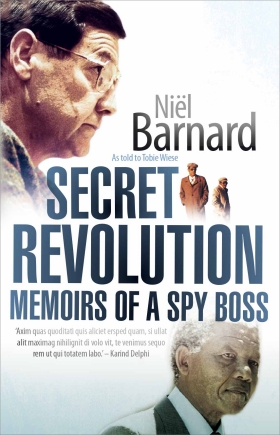TYING MANDELA'S SHOELACES: NIËL BARNARD'S ACCOUNT OF THE SECRET REVOLUTION
Niël Barnard's autobiography, Secret Revolution, provides an interesting insight into the secret negotiations between Nelson Mandela and the National Intelligence Service (NIS) in 1988/89 that helped prepare the way to the constitutional transformation of South Africa.
Barnard tells us how he established the NIS despite the opposition of the state's other intelligence agencies.
He also reveals the substantial role that NIS played in establishing secret ties with a number of African governments - often without the knowledge of the Department of Foreign Affairs.
He gives his assessment of the SADF's ‘forward strategy’ in terms of which it sought to defend the South African and Namibian borders by supporting UNITA in Southern Angola and Renamo in Mozambique. He implies that the SADF missed the crux of the South African problem - which was the need to reach a just political accommodation with black South Africans.
 In fact, the SADF had accepted at an early stage that there would have to be a political settlement but that in the meantime its primary duty was to protect the borders with Angola and Mozambique. Failure to do so might have resulted in a military take-over of Namibia by SWAPO - supported by the Cubans - and would have opened South Africa's industrial heartland to attacks from Mozambique - only 350 kms away.
In fact, the SADF had accepted at an early stage that there would have to be a political settlement but that in the meantime its primary duty was to protect the borders with Angola and Mozambique. Failure to do so might have resulted in a military take-over of Namibia by SWAPO - supported by the Cubans - and would have opened South Africa's industrial heartland to attacks from Mozambique - only 350 kms away.
The SADF's strategy in Mozambique led to the Nkomati Accord and to a substantial reduction in the cross-border threat. In southern Angola the SADF succeeded with consummate skill in holding SWAPO and the Cubans at bay for 13 crucial years. The SADF's crushing victory at the Battle of the Lomba River in October 1987 - which Barnard hardly mentions - finally broke the will of the disintegrating Soviet Union to continue its military adventures in Southern Africa. It led directly to the tripartite agreement between Cuba, Angola and South Africa, which in turn resulted in the withdrawal of Cuban forces from Angola and to the relatively successful implementation of the UN independence process in Namibia. These developments were crucial to the transformation process in South Africa.
The core of the book deals with the 48 meetings between Barnard and Nelson Mandela in 1988-89 that helped to prepare the way for Mandela's release and for the central role that he was destined to play. Barnard prides himself on his ability to read people and to articulate their thoughts - even before they have expressed them. The question is who read whom in his relationship with Mandela - the wily old revolutionary - or the young and inexperienced intelligence chief? Despite PW Botha’s warning, Barnard - like so many others - was mesmerised by Mandela and regarded him - and treated him - almost from their first meeting as the President-in-waiting. The defining image of the book is of Barnard kneeling down to tie Mandela's shoelaces before his meeting with PW Botha in July 1989.
However, the book makes no mention of the fact - attested to by Pik Botha and Koedoe Eksteen - that as late as 1987 Barnard regarded Mandela as a dangerous communist and was vehemently opposed to his release. The book does not tell us why he changed his mind.
In 1979, before he had even met him, PW Botha appointed Barnard - a 30-year-old political science lecturer at the University of the Orange Free State - as head of the NIS. He had immediate access to Botha - a crucial advantage in the inner politics of any government. He gives Botha full credit for his administrative skills and for his far-reaching reforms - while acknowledging the problems caused by Botha's irascible and dictatorial style.
He shows no such balance in his treatment of FW de Klerk. He writes of De Klerk's reluctant participation in the State Security Council where he likens him to a schoolboy in church who would rather be outside playing. He questions De Klerk's strategic ability and pours scorn on the manner in which he supposedly ganged up with others to oust the wounded PW Botha.
Indeed, De Klerk did not feel comfortable in the State Security Council, which he believed had usurped the functions of non-securocrat ministers like himself. In fact, De Klerk went out of his way to ensure that PW Botha would be able to finish his presidential term with honour - but there was no way the Groot Krokodil was going to leave office without a fight.
No doubt Barnard was disappointed because he did not have the same immediate access to De Klerk that he had always had with PW Botha. Their strained relationship probably had its roots in NIS's deliberate failure to inform De Klerk of the first crucial meeting overseas between NIS and the ANC - even though De Klerk had already taken over as Acting President. NIS once again misread De Klerk by thinking that he might have prohibited or interfered with the meeting had he known about it beforehand.
Barnard is proud of the effectiveness of the NIS. However, the key requirement at the commencement of the negotiations was for accurate intelligence on the true intentions of the ANC - and the degree to which it was still influenced by the SACP. It emerged quite soon after the transition that the ANC had never viewed 1994 as the culmination of its struggle but merely as a beachhead in its continuing national democratic revolution. Constitutional compromises could be dispensed with as soon as shifts in the balance of power allowed - and the SACP viewed the NDR as the precursor to the establishment of a communist state. Was the NIS aware of these intentions before 1994 and did it bring them insistently to the attention of the government's negotiators? If not, why not?
Subsequently, the greatest threat to the negotiations came from violence perpetrated by faceless elements on all sides of the conflict. There were widespread allegations of complicity by rogue members of the Security Forces. In the end, it was the Goldstone Commission - appointed by De Klerk - that uncovered the operations of the Directorate of Covert Collections in November 1992 - and finally of the Vlakplaas unit in March, 1994. These activities were in direct conflict with De Klerk's clearly expressed orders and were intended to derail the negotiations. Why was the NIS - with all its vaunted capabilities - unable to obtain intelligence on this quintessential threat and advise the President accordingly?
Niël Barnard undoubtedly played an important role in the birth of the new South Africa. (We look forward to hearing about his subsequent role as the Head of the Constitutional Development Service during the negotiations.) He had a very healthy appreciation of his own abilities and of those of the NIS. He accepted axiomatically that Nelson Mandela would become the next President - and within this framework strove to secure the best deal for his people - the Afrikaners - that he could. However, in retrospect, was PW Botha's decision to appoint a 30-year-old academic - whom he had never previously met - as the head of the country's main intelligence agency at such a crucial time in our history, really so wise?
Dave Steward is Executive Director of the FW de Klerk Foundation

